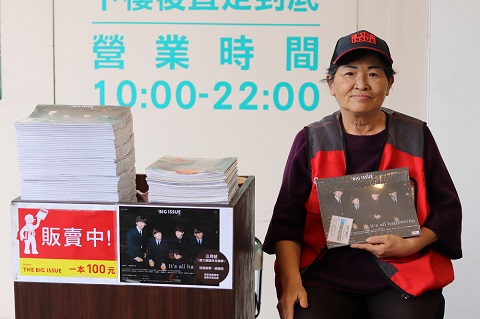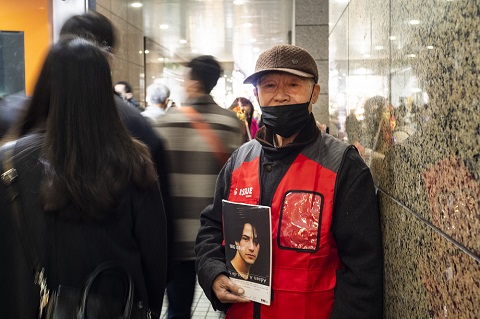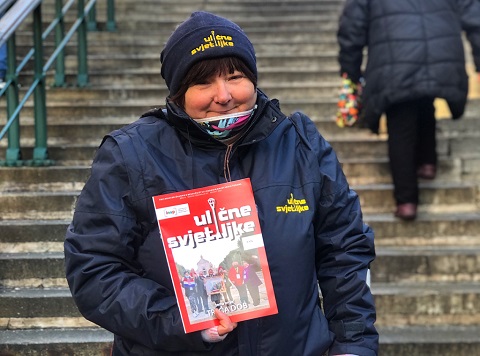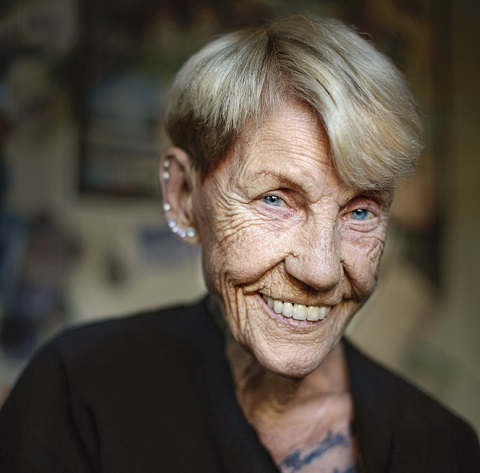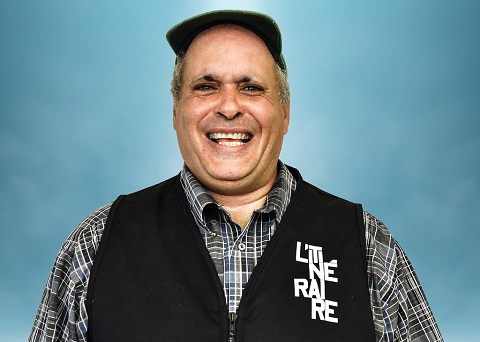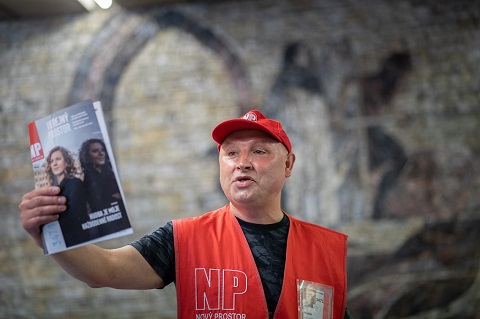By Hubert Ostendorf, fiftyfify
Can images and film achieve change? Renowned Italian author and film director Pier Paolo Pasolini (born 1922, died 1975) once said: “Trying to have an impact on people is a bit like trying to scoop out the ocean with a thimble”. While advertising expert Darren Richardson, who together with his team at advertising agency Havas was responsible for the idea of “Repicturing Homeless“, does not believe that “photos can solve an issue like homelessness”, he does maintain that they can at least promote “scrutiny of visual stereotypes”.
Scrutiny? That’s actually an understatement – there’s far more to it than that. In fact, it’s ultimately about contemplating what makes us human. And the meaning of status symbols. And how mercilessly we are all reduced to such symbols by our society, radically defined as it is by power and consumption. Even in the pre-digital era, Pasolini coined the phrase “hedonistic fascism”, referring to the pressure to acquire as much as possible, in his visionary work Corsair Writings – which we might interpret as greed that brutally oppresses both the individual and wider society. According to Pasolini, we suffer as individuals if we allow ourselves to be defined by prescribed patterns of consumption – the poor because they dream about what they neither have nor really need, and the rich because they have a compulsive desire to possess things which, although costly, are existentially meaningless. Ultimately society as a whole suffers as well, because it allows its vision and values to be dominated by advertising for something as inane as a new pair of trousers, quite literally in some cases. Pasolini wrote an essay – world-famous in his time – regarding a clothing manufacturer’s blasphemous slogan: “Thou shalt not have any other jeans but me”. He once, in a different context, summarised the situation as follows: “the real anti-democracy is mainstream culture”.
We want to prompt people to challenge their perceptions of our fellow human beings, influenced as these ideas often are by privilege
Ironically, “Repicturing Homeless” was created by an advertising agency – of all things – whose purpose, like all agencies, is to expertly arouse the obsessive desires of target markets around the world. And yet “Repicturing Homeless” provides a new perspective not only on the losers of consumerism, but also on ourselves. What are we, when we have nothing left? Probably not a concern often discussed within the advertising industry.
But this fundamental question – concerning our own sense of self – may resonate, for example, when formerly homeless Kalle sees himself in the mirror wearing business wear, designer glasses, and a luxury watch, and breaks down in tears. This fiftyfifty seller, 56 years old and an alcoholic, languished on the street, on the bottom rung of society, for over 20 years before recently – finally – receiving a flat as part of this street paper’s Housing First programme. In between sobs, he confesses: “I feel like a new person”. Jennifer, meanwhile, is dressed as a waitress, in less luxurious attire but nevertheless beautifully groomed. At first she can’t quite credit her transformation – until, waiting around in the posh hotel where the shoot is taking place, at a moment when the lens of star photographer Frank Schemmann’s camera is not pointed her way, a more senior member of staff reprimands her, asking whether she has nothing better to do than stand around gawking. He took her for a hotel employee. “That’s when I first realised just how big a part clothing plays”, says Jennifer. She continues, resigned: “It shows what I could be. But it takes more than just clothes. Even in an outfit this fancy, I still wouldn’t get by in a meritocracy”.
Karl-Heinz Hasenjäger, also 56, is in a similar situation. In his own words, he was “born on the street” – his parents were homeless before him. Karl-Heinz was photographed as a fashion designer and he found the new role a surprisingly good fit too. “Somehow, they’ve recognised the creative core in my personality”, the talented amateur painter explains, full of appreciation. But real life has not been so kind to him. Karl-Heinz currently lives in a shabby shelter, light years away from a life as a recognised creative force. He enjoys this dream of a better future so much, and yet he is so imprisoned in his own small world – which he bears with a singular sense of humour. You could say “gallows humour”, he laughs. Having a realistic understanding of his position and finding a certain satisfaction in it is “my own way of coping”, he muses. Remaining humble, when prospects are thin on the ground, without giving in to desperation. And a strategy for surviving.


The same can’t be said for Michael Hermann, whom everybody refers to as Hörman. This man, visibly scarred by life and now living in a fiftyfifty flat after more than twenty years under bridges and on the street, still harbours lofty dreams. Fittingly, the creative team at Havas and photographer Schemmann saw a professor in him: decked out in expensive clothes and proudly striding around the set, he plays the role perfectly. Although Hörman himself admits that it couldn’t be much further from his own, abject reality, he remains hopeful. “Life is full of surprises”, he murmurs into his red beard, as he writes Einstein’s famous formula onto a window for a photo. Could Einstein be his alter ego? Probably not what Hörman means. Instead, the chance that it might one day be possible to overcome the constraints of a fate characterised by dependence on drugs or other pitfalls.
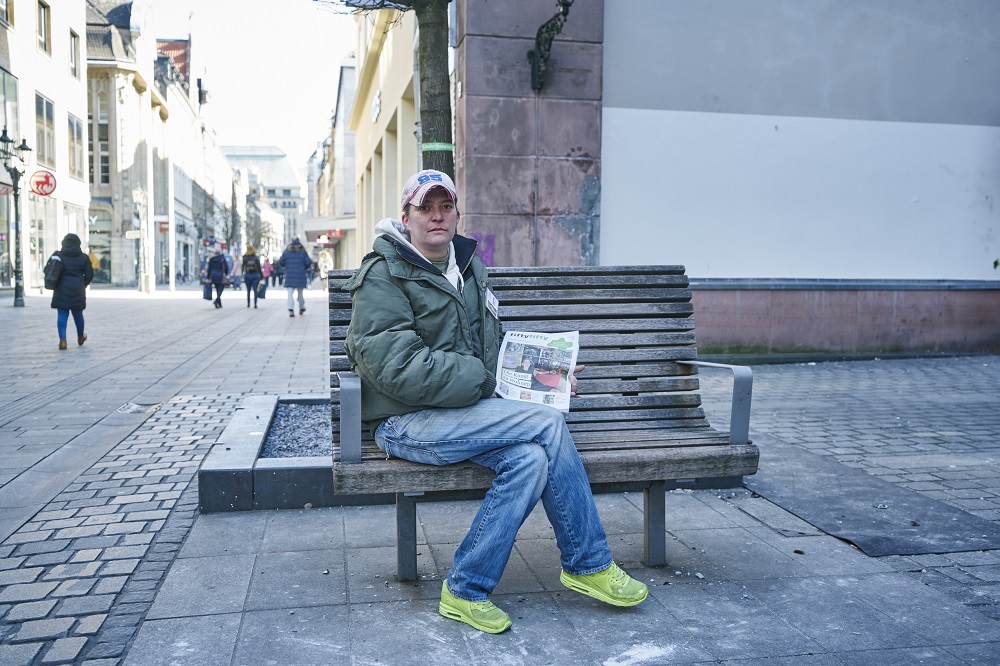

A different perspective on yourself is something that self-awareness can provide, certainly, but first and foremost something revealed by the way your environment responds to you. And this is exactly why it’s not just the costume that has the impact – it’s also the action of documenting it in photographic form. More than anything else, it’s the disparaging looks when she sells her street paper that make 36 year-old Vanessa, homeless for over a decade, feel discriminated against. She can use the photos that she’ll now keep on her cheap mobile phone to get the message across to people: look, this is me as well. Not just the woman on the street, whom conceited fellow human beings dart past with unkind judgements on their lips. “Get a job!” – time and time again, this patronising demand. As if selling a street paper wasn’t work. Though it’s probably not seen as proper, accepted work by much of society. That’s something Vanessa has only experienced once in her life. On just one day – and even then it was only a feeling: at the photo shoot for “Repicturing Homeless”. What the images captured at the shoot are capable of conveying does, in the end, have a certain value to society. Vanessa realised that this was the case after the media suddenly started to show an interest in her – she keeps having to retell her life story. And the attention is benefiting her, because Vanessa, much like other people condemned on the street, is suddenly able to use her visual transformation to help present a lesson about the state of our post-fact, capitalist society. A lesson about the dangers we face. Because Vanessa and the others hold a mirror up to ourselves. Look out – the same thing could happen to you in this predatory economy. We could all stumble. Be a Vanessa. Or a Kalle.

Darren Richardson, Chief Creative Officer at Havas, has the following take: “Instead of clichéd, conventional images of desperation and poverty, we’ve tried to surprise people and encourage them to think with our campaign. Our approach is not intended to leave people downcast or with a heavy conscience – first and foremost, we want to prompt people to challenge their perceptions of our fellow human beings, influenced as these ideas often are by privilege.”
Paul Foster, Senior Director at Getty Images, adds: “We believe that the photos have the power to change perceptions, even inspire compassion, drive changes”. In other words, images can achieve change. This means, according to Foster, that the “Repicturing Homeless” project will directly benefit the disadvantaged people that fiftyfifty looks after. Getty Images will donate every last penny of the proceeds from the sale of the photo licences to magazines, newspapers and websites, to fiftyfifty housing projects for the homeless. In this respect, images can definitely have an impact.
Translated from German by Alex Green





